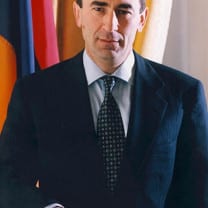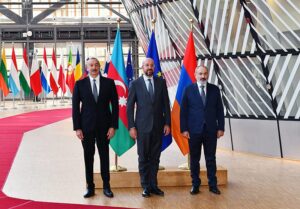Early elections were called by Prime Minister Nikol Pashinyan in April, as the country had been in a political crisis since the lost war against Azerbaijan. Much has changed since April and the tide seems to be turning against Pashinyan. Former President Robert Kocharyan is hoping to make a comeback into politics, having set up the Armenia Alliance in May. It seems like the both Pashinyan’s Civil Contract (KP) and the Armenia Alliance could both still well become the country’s largest party. Many voters remain undecided though, in a campaign marked by personal attacks, the Nagorno-Karabakh war and with virtually no discussion on actual policies.
Early elections called as pressure on Pashinyan intensified
In December of 2018 Pashinyan and his My Step Alliance (My Step) still convincingly won the elections with 70.4% of the votes. Pashinyan remained relatively popular until the 44-day long war with Azerbaijan broke out last fall. The war turned out disastrous for Armenia as many of its soldiers fell victim. Armenia had to cede large parts of its territory to Azerbaijan, especially in the Nagorno-Karabakh region. These included territories which Armenia had controlled for over 30 years. After Pashinyan signed a trilateral peace agreement with Azerbaijan and Russia, large scale protests broke out in the country.
Protesters and opposition parties have been calling for Pashinyan’s resignation and re-elections. The opposition parties united against the Pashinyan-led government as the Homeland Salvation Movement (HSM). The HSM consisted of sixteen opposition parties, including the Prosperous Armenia party (PEP), the Bright Armenia party (BAP) and other parties which are not represented in parliament. The conflict intensified as many more proponents and opponents of Pashinyan took to the streets in the following days. Talks between Pashinyan and opposition leaders started then, eventually resulting in Pashinyan paving the way for early elections to take place.
Wide array of parties challenging Pashinyan
Elections were initially scheduled for 9 December 2023, but on June 20th Armenians will head to the polls. At least 101 seats will be distributed, but this number can rise as seats are allocated. Four seats are reserved for minorities. Meanwhile, there are methods to balance the allocation of seats between the ruling faction and opposition if the difference become too slim or large. Moreover, Armenia’s party-list proportional representation also has an electoral threshold of 5% for parties and 7% for multi-party alliances. With over twenty parties participating in the elections, only few are expected to make it into parliament.
Previously, 83 out of 132 seats in parliament are held by ruling faction, the My Step Alliance. This alliance was dissolved in May though. Pashinyan’s party and the largest in the alliance, Civil Contract (KP), is running independently now. The only two other opposition groups that held seats in parliament before, the Prosperous Armenia party (PAP) and Bright Armenia party (BAP) are participating, but just might fall short of the threshold. The PAP is led by Armenia’s wealthiest businessman Gagik Tsarukyan and previously held 23 seats in parliament. The BAP is led by Edmon Marukyan and held 17 seats before elections were called.
There is a wide array of newly formed parties and alliances, which hope to challenge the established parties, and Pashinyan’s KP specifically. Most notable is the Armenia Alliance, which was formed only in May of this year. Its party leader and former president of Armenia, Robert Kocharyan, is seriously challenging Pashinyan for the post of prime minister. Former head of the National Security Service, Arthur Vanetsyan leads the I’m Honored Alliance, which was also established only this May. This alliance consists of the Vatesyan’s Homeland Party and the Republican Party of Armenia (RPA), which had long ruled the country.
The circumstances drastically changed since elections were called
It long seemed like Pashinyan’s My Step Alliance, despite the large scale protests, would still become Armenia’s largest party again. To voters it seemed there were no alternatives. This changed when two new political forces were established in May. Meanwhile, the My Step Alliance was dissolved and KP decided to run by itself. At the end of March the My Step alliance was still expected to gain 31.7% of the votes. KP now is predicted to gain only 23.8% of the votes. Shortly after its establishment, the Armenia Alliance polled at 14.3%. However, the party of well-known Kocharyan has overtaken the KP in the latest poll, scoring 24.1%.
The only other party is the most recent poll to break the electoral threshold, is the I Have Honor Alliance. Relying on the former popularity of the RPA it now is predicted to win 7.4% of the votes. PAP and BAP are expected to gain 3.7% and 3.1% of the votes respectfully. The other participating parties all scored below 2.5%. However, many voters also remains undecided, with over a third of voters not expected to vote on any of the five parties mentioned above. This is possibly due to the lack of viable “alternatives” within these major parties. The election campaign so far has become intense, with many personal accusations from one side to the other.
There have been virtually no discussions on different proposed policies. This is no surprise given the nature of the five mentioned political parties, which almost all classify as big-tent catch-all alliances and are built around their leaders. With the lack of any discussion on economic policies between the left and right, many voters will remain disappointed in the country’s politics. What could make the difference for many other voters though, is the issue of losing Nagorno-Karabach to Azerbaijan. Kocharyan is claiming to a take a much tougher stance against Azerbaijan than Pashinyan was doing. To some the election might still feel like choosing between “two evils”.
Image: Wikimedia (Robert Kocharyan during his Presidency, 2006)
Sources: ArmenianWeekly1, ArmenianWeekly2, EurasiaNet1, EurasiaNet2, EVN, Rferl



